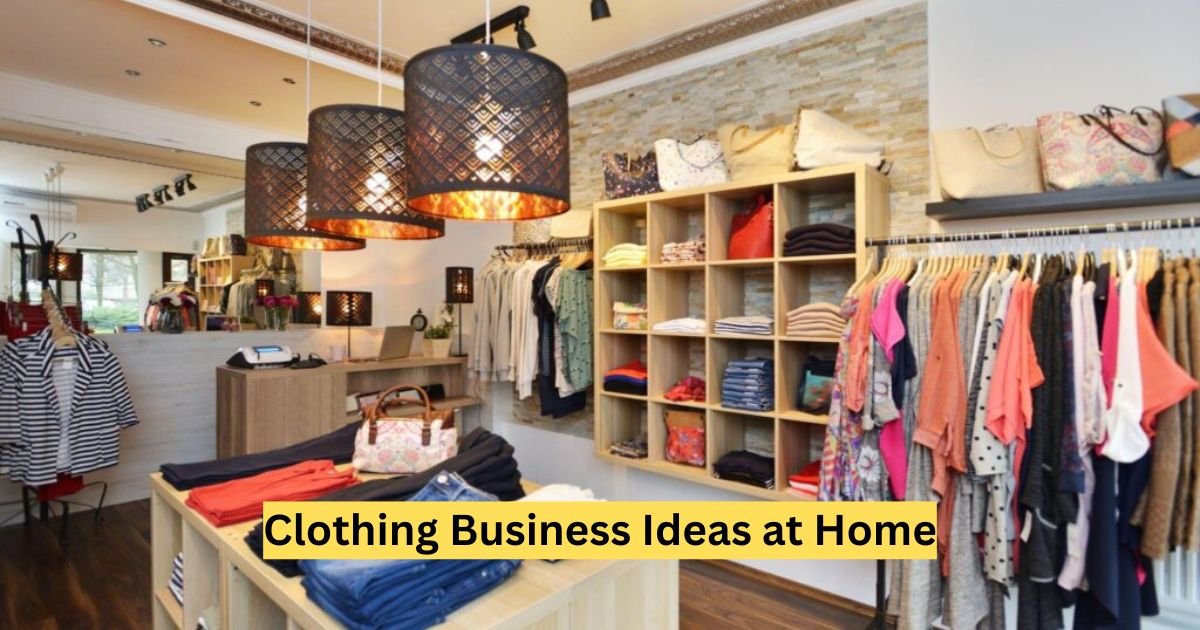Starting a clothing business from home is an exciting way to turn your passion for fashion into a profitable venture. With low startup costs, endless creative possibilities, and the rise of e-commerce, anyone with a vision can launch a successful clothing brand from their living room. This article explores innovative clothing business ideas, practical tips, and real-world examples to help you kickstart your home-based fashion journey.
Whether you’re a skilled seamstress, a graphic designer, or a trend enthusiast, there’s a clothing business idea that fits your skills and budget. Let’s dive into the best opportunities to create a thriving fashion business from home.
Why Start a Clothing Business from Home?
The global apparel market is projected to reach $2.25 trillion by 2027, according to Statista, driven by e-commerce and consumer demand for unique, sustainable fashion. Starting a clothing business at home offers:
-
Low Overhead Costs: No need for a physical store or office space.
-
Creative Freedom: Design products that reflect your unique style.
-
Flexible Schedule: Work on your terms, perfect for stay-at-home parents or side hustlers.
-
E-commerce Opportunities: Platforms like Etsy, Shopify, and Instagram make selling online seamless.
But how do you choose the right idea? Below are some of the most profitable and beginner-friendly clothing business ideas you can start from home.
Top Clothing Business Ideas to Start at Home
1. Custom T-Shirt Printing
Custom t-shirts are a low-cost, high-demand product. With print-on-demand (POD) services like Printful or Teespring, you can create unique designs without holding inventory.
-
How to Start:
-
Use design tools like Canva or Adobe Illustrator to create eye-catching graphics.
-
Partner with a POD platform to handle printing and shipping.
-
Market your t-shirts on Instagram or TikTok with niche-specific designs (e.g., “Funny Cat Mom Tees”).
-
-
Real-World Example: Merch by Amazon sellers like Sarah, who earns $5,000 monthly by designing niche t-shirts for dog lovers, show the potential of this model.
-
Pro Tip: Target micro-niches like “yoga teacher apparel” or “gamer tees” to stand out.
2. Sustainable Fashion Brand
Consumers are increasingly eco-conscious, with 73% of Gen Z willing to pay more for sustainable products (Nielsen). A home-based sustainable clothing line focusing on organic fabrics or upcycled materials can attract this demographic.
-
How to Start:
-
Source eco-friendly materials like organic cotton or recycled polyester.
-
Use a sewing machine to create small-batch designs like tote bags or minimalist dresses.
-
Sell on platforms like Depop or Etsy with a focus on “slow fashion.”
-
-
Real-World Example: Reformation, a sustainable brand, started small and now generates millions by prioritizing eco-friendly practices.
-
Pro Tip: Share your sustainability story on social media to build trust and attract eco-conscious buyers.
3. Handmade Accessories
Accessories like scarves, hats, or jewelry require minimal materials and are perfect for home-based entrepreneurs with crafting skills.
-
How to Start:
-
Learn basic knitting, crocheting, or beading techniques via YouTube tutorials.
-
Create seasonal collections (e.g., winter beanies or summer headbands).
-
Sell at local craft fairs or online marketplaces like Etsy.
-
-
Pro Tip: Use high-quality product photos to make your accessories pop online.
4. Dropshipping Clothing Boutique
Dropshipping lets you sell clothing without handling inventory. You create an online store, and suppliers ship products directly to customers.
-
How to Start:
-
Set up a Shopify store and integrate with dropshipping apps like Oberlo or Spocket.
-
Curate trendy clothing items like athleisure or boho dresses.
-
Use social media ads to drive traffic to your store.
-
-
Pro Tip: Focus on a specific aesthetic (e.g., “minimalist chic”) to attract a loyal audience.
5. Vintage Clothing Resale
The secondhand clothing market is booming, expected to hit $77 billion by 2025 (ThredUp). Reselling vintage or thrifted clothing is a low-cost way to start.
-
How to Start:
-
Source unique pieces from thrift stores, garage sales, or wholesalers.
-
Clean, repair, and style items for professional photos.
-
Sell on platforms like Poshmark, eBay, or Depop.
-
-
Real-World Example: Nasty Gal began as a vintage resale business on eBay, growing into a global brand.
-
Pro Tip: Use hashtags like #VintageFashion or #ThriftedStyle to boost visibility on Instagram.
6. Kids’ Clothing Line
Parents love unique, high-quality clothing for their kids. A home-based children’s clothing brand can tap into this lucrative market.
-
How to Start:
-
Design simple items like onesies or matching family outfits.
-
Use soft, safe fabrics like organic cotton.
-
Market to parents through mommy blogs or parenting groups on Facebook.
-
-
Pro Tip: Offer personalized options, like embroidered names, to increase perceived value.
How to Market Your Home-Based Clothing Business?
Marketing is the key to standing out in a competitive industry. Here’s how to promote your clothing brand effectively:
-
Build a Strong Online Presence:
-
Create a visually appealing Instagram or TikTok account showcasing your products.
-
Use storytelling to connect with your audience (e.g., “Why I started my sustainable fashion journey”).
-
-
Leverage SEO and Content Marketing:
-
Start a blog with articles like “How to Style Sustainable Fashion” to drive organic traffic.
-
Optimize product descriptions with long-tail keywords like “handmade organic cotton scarves.”
-
-
Collaborate with Influencers:
-
Partner with micro-influencers (5,000–20,000 followers) in your niche for affordable promotions.
-
Example: A sustainable fashion brand might send free products to eco-bloggers.
-
-
Offer Promotions:
-
Run limited-time discounts or bundle deals (e.g., “Buy 2 tees, get 1 free”).
-
Use email marketing to re-engage past customers.
-
What Are the Challenges of Running a Home-Based Clothing Business?
While starting a clothing business at home is rewarding, it comes with challenges:
-
Time Management: Balancing design, production, and marketing can be overwhelming.
-
Solution: Use tools like Trello or Asana to organize tasks.
-
-
Inventory Management: Overstocking or understocking can hurt profits.
-
Solution: Start with print-on-demand or small-batch production to minimize risk.
-
-
Competition: The fashion industry is crowded, making it hard to stand out.
-
Solution: Focus on a unique selling proposition (USP), like eco-friendly materials or niche designs.
-
How Much Does It Cost to Start a Clothing Business at Home?
The cost depends on your business model, but here’s a breakdown for beginners:
-
Custom T-Shirt Printing: $100–$500 (design software, marketing, POD setup).
-
Sustainable Fashion Brand: $500–$2,000 (fabrics, sewing machine, website).
-
Vintage Resale: $50–$300 (initial inventory, shipping supplies).
-
Dropshipping Boutique: $200–$1,000 (website, ads, apps).
Pro Tip: Start small and reinvest profits to scale gradually.
Tips for Success in Your Home-Based Clothing Business
-
Stay Trend-Aware: Follow fashion blogs and Pinterest to spot emerging trends.
-
Prioritize Customer Service: Respond promptly to inquiries and offer hassle-free returns.
-
Test Your Products: Get feedback from friends or local markets before scaling.
-
Learn Basic Photography: High-quality photos increase conversions by up to 30% (Shopify).
See Also: top10ideas.org
Conclusion
Starting a clothing business from home is an achievable and rewarding way to enter the fashion industry. Whether you’re designing custom t-shirts, curating vintage finds, or launching a sustainable brand, the opportunities are endless. With creativity, smart marketing, and a focus on customer needs, you can build a thriving business without leaving your home.
Ready to take the first step? Choose one of the ideas above, create a simple business plan, and start small. The fashion world is waiting for your unique vision!




